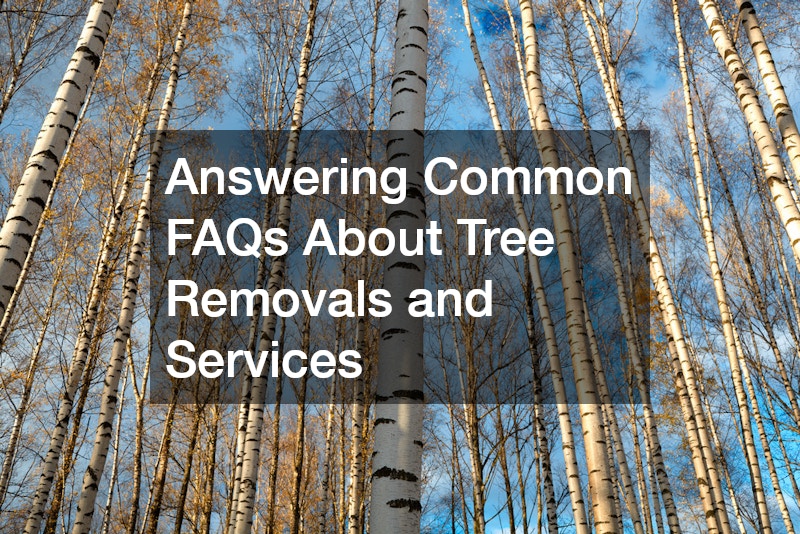
Introduction
Tree removal and various tree services play a crucial role in maintaining the health, safety, and aesthetic appeal of your landscape. Trees contribute significantly to the beauty and functionality of outdoor spaces, but they require proper care and management to ensure their longevity and safety. This comprehensive guide seeks to answer some of the most frequently asked questions about tree removals and the diverse range of tree services available. Whether you’re considering hiring a local tree service company or simply want to understand the process better, this article will provide you with the information you need.
1. What are the types of tree services available?
Understanding the different types of tree services can help you make informed decisions about the care and maintenance of your trees. Here are some of the primary services offered by tree care professionals:
1.1. Tree Removal
One of the most common services offered by local tree services is reliable tree removal. This process involves cutting down a tree that is no longer safe or beneficial to the landscape. Reasons for tree removal can vary, including disease, damage, or hazardous conditions. A professional service ensures that the tree is removed efficiently and safely, minimizing the risk of property damage or injury. The process typically includes cutting the tree down, removing the trunk, and clearing away branches and debris.
1.2. Tree Pruning and Trimming
Tree pruning and trimming are essential for maintaining a tree’s health and appearance. Tree pruning and trimming involves selectively removing branches to improve the tree’s structure, enhance its growth, and eliminate any dead or diseased parts. This practice not only helps in maintaining the tree’s aesthetic appeal but also in promoting better air circulation and light penetration. Regular pruning can prevent potential hazards caused by overgrown branches and enhance the overall health of the tree.
1.3. Stump Grinding and Removal
After a tree is cut down, the remaining stump can be an unsightly and potentially hazardous obstacle. Stump grinding and removal is the process of eliminating these stumps from your landscape. Stump grinding involves using specialized equipment to grind the stump down to below ground level, allowing you to use the area for other purposes. This service also helps in preventing pest infestations and minimizing the risk of tripping accidents.
2. Why might a tree need to be removed?
There are several reasons why a tree might need to be removed from your property. Understanding these reasons can help you determine when it’s time to seek professional assistance:
2.1. Disease or Pest Infestation
One of the most common reasons for tree removal is disease or pest infestation. Trees that are afflicted with diseases or overrun by pests can pose serious risks. Diseases such as root rot or blight can weaken a tree and make it unsafe. Similarly, pests like beetles or termites can cause structural damage. In such cases, emergency tree service may be required to address the problem swiftly and prevent further damage or spread.
2.2. Structural Damage or Instability
Trees that have sustained significant structural damage or instability might pose a threat to your property. Storms, high winds, or accidents can cause trees to lean or develop weak spots. An unstable tree can become a safety hazard, especially if it is leaning toward structures or power lines. Professional evaluation is crucial to determine whether the tree needs to be removed to avoid potential damage or accidents.
2.3. Safety Hazards
Trees that present safety hazards due to their size, location, or condition need to be addressed promptly. Factors such as safety hazards might include branches that overhang power lines, trees growing too close to buildings, or trees with large dead branches that could fall. In these situations, removing the tree is often the best course of action to ensure the safety of your property and its occupants.
3. How do professionals assess a tree’s health?
Assessing the health of a tree involves a combination of visual inspections, diagnostic tools, and expert evaluations. Here’s how professionals typically go about it:
3.1. Visual Inspections
A visual inspection is the first step in assessing a tree’s health. Tree care professionals will examine the tree’s overall appearance, including its leaves, branches, and trunk. They look for signs of disease, pest infestation, or structural issues such as cracks and decay. Visual inspections provide a preliminary understanding of the tree’s condition and help determine if further diagnostic measures are needed.
3.2. Diagnostic Tools
In some cases, professionals use specialized diagnostic tools to gain a deeper insight into the tree’s health. Tools such as sonic tomography or resistographs can detect internal decay or structural weaknesses that may not be visible from the outside. These tools help in assessing the extent of any damage or disease and guide the decision-making process regarding tree removal or treatment.
3.3. Expert Evaluations
Expert evaluations involve consulting with experienced arborists who use their knowledge and experience to assess the tree’s health comprehensively. An arborist’s evaluation includes interpreting visual and diagnostic data, considering environmental factors, and providing recommendations for treatment or removal. This expert advice is invaluable in making informed decisions about tree care.
4. What should you look for in a tree removal service provider?
Choosing the right tree removal service provider is crucial for ensuring that the job is done safely and efficiently. Here are key factors to consider:
4.1. Proper Licensing and Insurance
When selecting a local tree removal service provider, it is essential to verify that they have the proper licensing and insurance. Licensing ensures that the company meets local regulations and industry standards. Insurance protects you from liability in case of accidents or damage during the removal process. A reputable provider will have both licensing and insurance to guarantee a professional and secure service.
4.2. Experience and Expertise
Experience and expertise are critical when it comes to tree removal and other tree services. Look for a provider with a proven track record and a team of skilled professionals. An experienced provider will have the knowledge to handle various types of trees and complex removal situations. Their expertise ensures that the job is done correctly, minimizing risks and maximizing efficiency. They may offer other services as well, such as irrigation system installations.
4.3. Customer Reviews and Testimonials
Customer reviews and testimonials provide valuable insights into the quality of service offered by a tree removal company. Check online reviews and ask for references from previous clients. Positive feedback and high ratings are indicators of a reliable and trustworthy service provider. Reviewing testimonials can help you gauge the level of customer satisfaction and the company’s reputation in the industry.
5. How much does tree removal cost?
Understanding the cost of tree removal can help you budget appropriately and make informed decisions. Several factors influence the cost of tree removal:
5.1. Factors Affecting Cost
The cost of tree removal can vary based on several factors. These include the size and height of the tree, its location, and the complexity of the removal process. Trees that are difficult to access or located close to structures may require additional equipment or time, increasing the overall cost. Other factors such as the tree’s health, the presence of obstacles, and disposal of debris can also affect the final price.
5.2. Average Cost Range
While the cost of tree removal can vary widely, the average cost typically ranges from $200 to $2,000, depending on the factors mentioned above. Smaller trees or those with straightforward removal may fall on the lower end of the spectrum, while large or complex removals can be more expensive. It’s important to get a detailed estimate from a professional to understand the specific costs associated with your tree removal project. Get in touch with local tree contractors.
5.3. Getting a Quote
To get an accurate quote for tree removal, it’s advisable to contact multiple service providers and request detailed estimates. Most companies will provide a free quote based on an on-site assessment of the tree and the surrounding area. Comparing quotes from different providers can help you find a competitive price while ensuring that you choose a reputable company for the job.
6. What are the benefits of tree pruning and trimming?
Tree pruning and trimming offer several benefits that contribute to the overall health and appearance of your trees and landscape:
6.1. Improved Health and Growth
Regular tree pruning and trimming are essential for maintaining the health and promoting the growth of your trees. Removing dead or diseased branches helps prevent the spread of disease and encourages new growth. Proper pruning techniques ensure that the tree’s energy is directed towards healthy branches and foliage, enhancing its overall vitality and longevity.
6.2. Enhanced Appearance
Tree pruning and trimming can significantly improve the appearance of your trees and landscape. By removing overgrown or unsightly branches, you can shape the tree to enhance its natural beauty and complement your landscape design. A well-maintained tree adds aesthetic value to your property and creates a more polished and inviting outdoor space.
6.3. Safety and Risk Mitigation
Pruning and trimming also play a crucial role in safety and risk mitigation. Overgrown or dead branches can pose hazards, such as falling and causing damage to property or people. Regular maintenance helps identify and address potential risks, ensuring that your trees remain safe and do not become a liability. Proper pruning can prevent dangerous situations and contribute to a safer environment.
7. What is the process of stump grinding and removal?
Stump grinding and removal are important for clearing your landscape after a tree has been cut down. Here’s an overview of the process:
7.1. Stump Grinding Techniques
Stump grinding techniques involve using specialized machinery to grind the remaining tree stump into small wood chips. This process reduces the stump to below ground level, making it easier to cover with soil or landscape material. Grinding eliminates the visual and physical obstruction of the stump, allowing for a cleaner and more usable area.
7.2. Equipment Used
The equipment used for stump grinding includes a stump grinder, which is a machine with a rotating blade designed to cut through the wood. The grinder’s size and power vary depending on the size of the stump and the complexity of the removal. Stump grinders are designed to handle a variety of stump sizes and can grind stumps down several inches below the soil surface. The use of this equipment ensures that the removal process is efficient and thorough, leaving minimal residue behind. Contact a tree trimming company.









